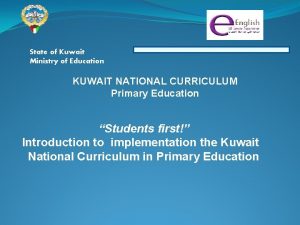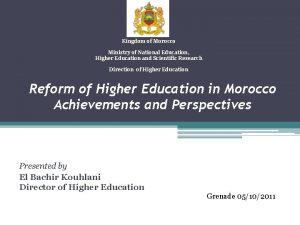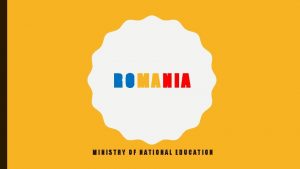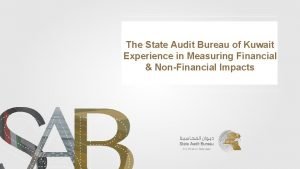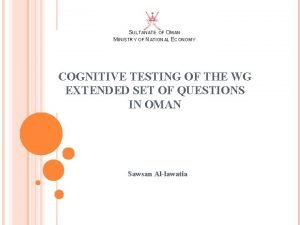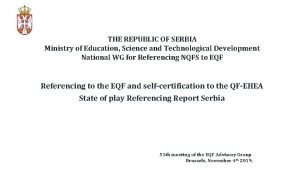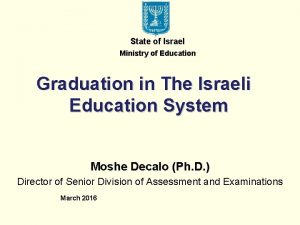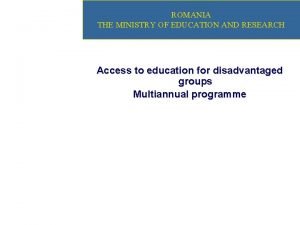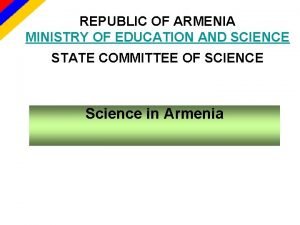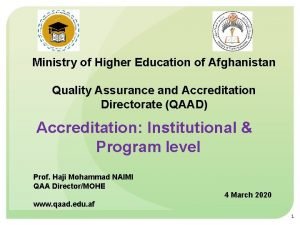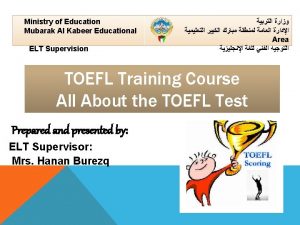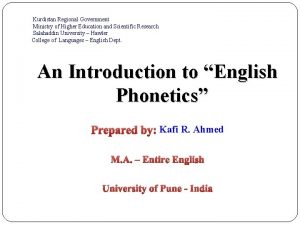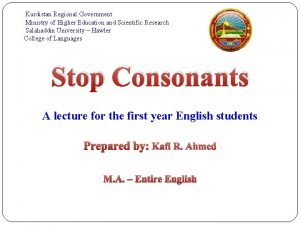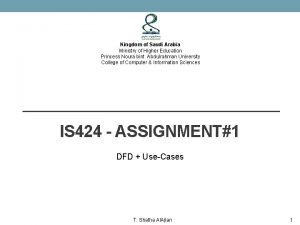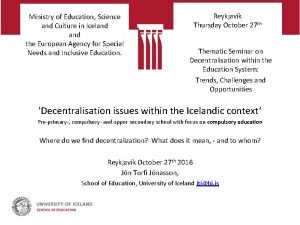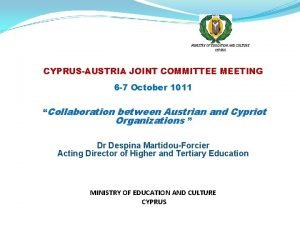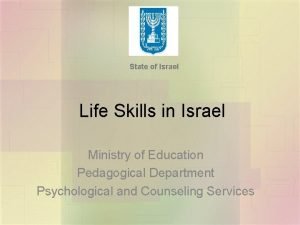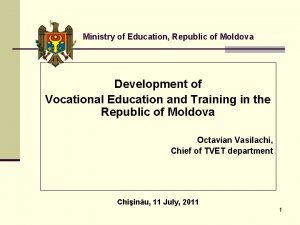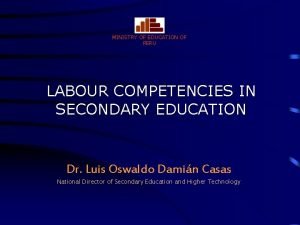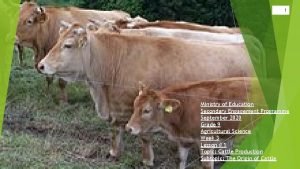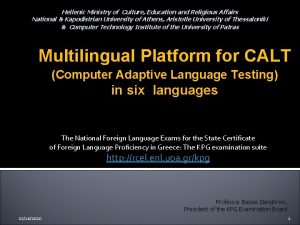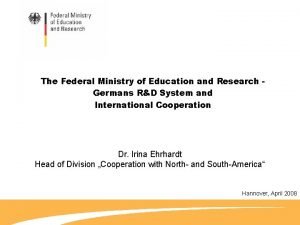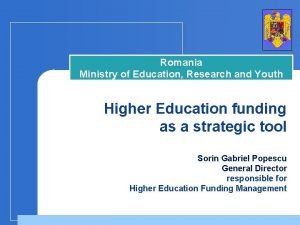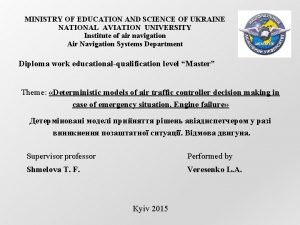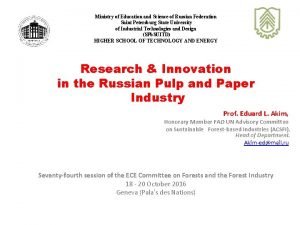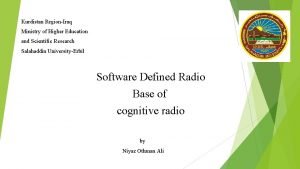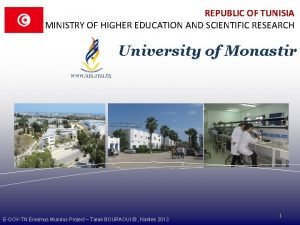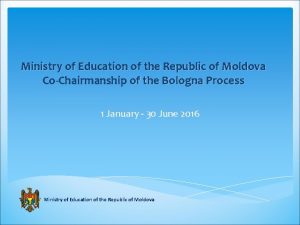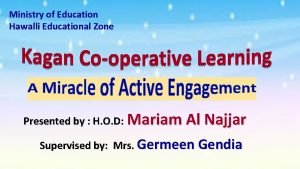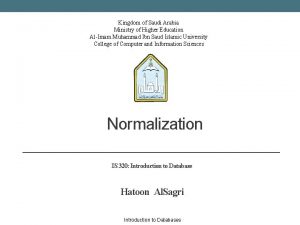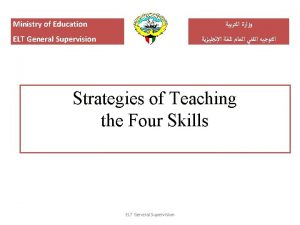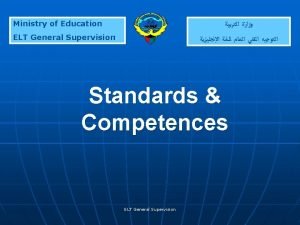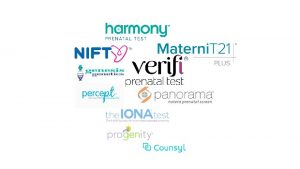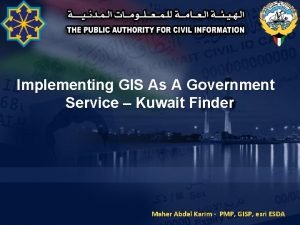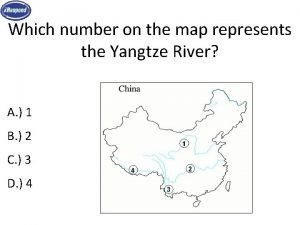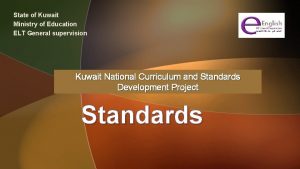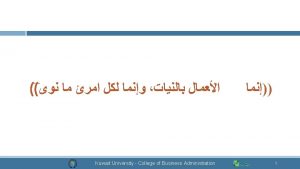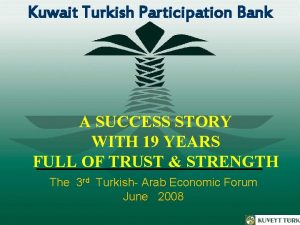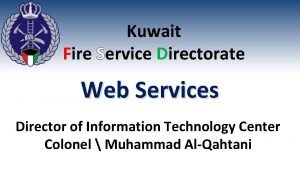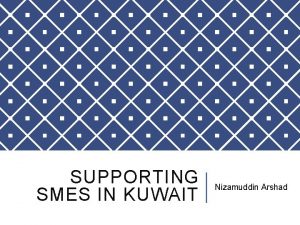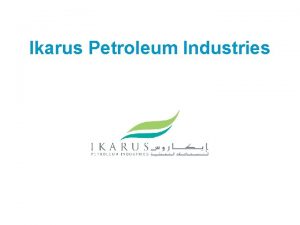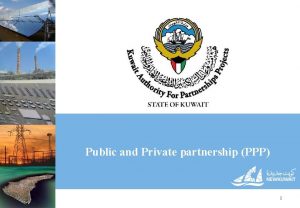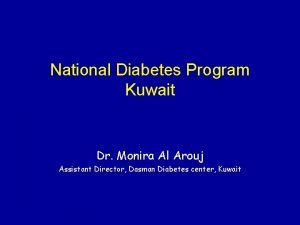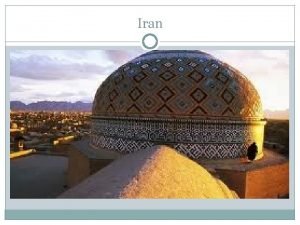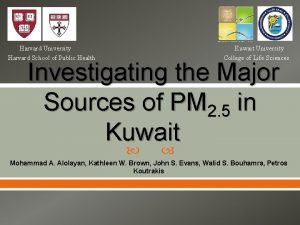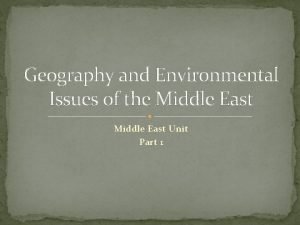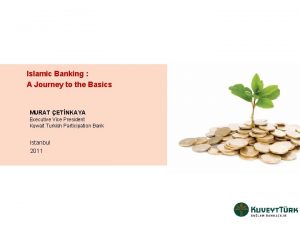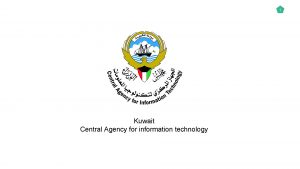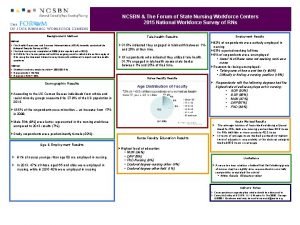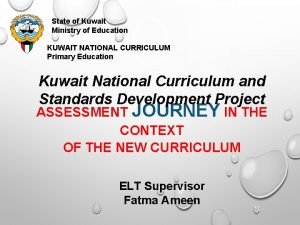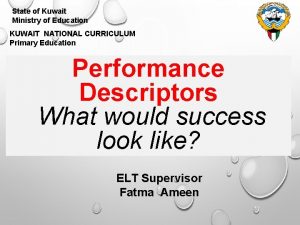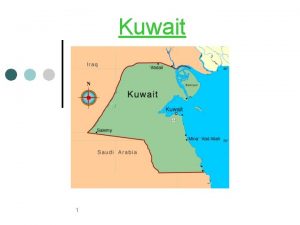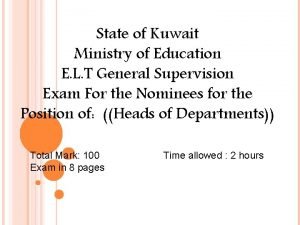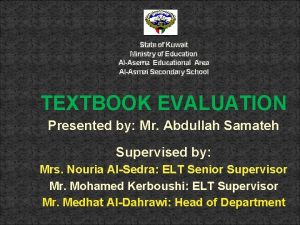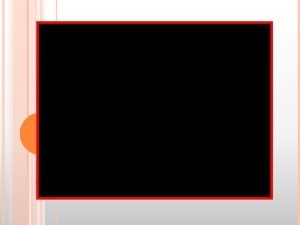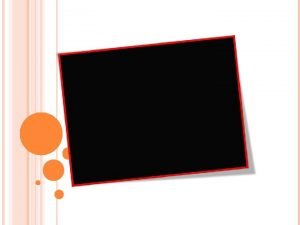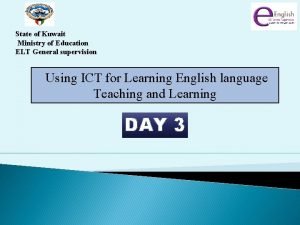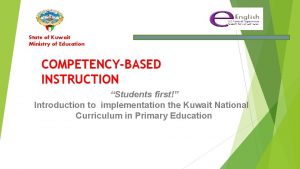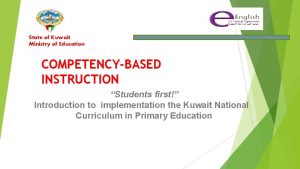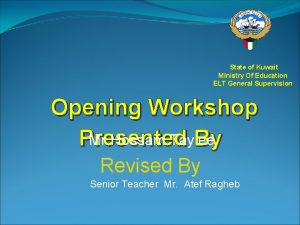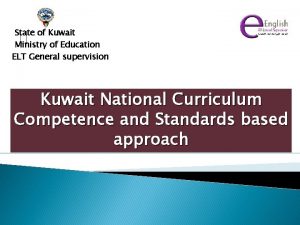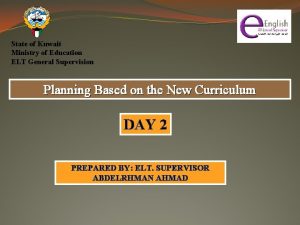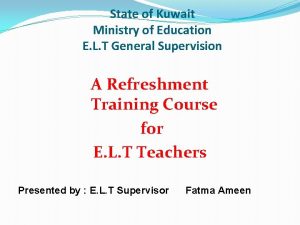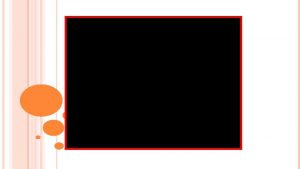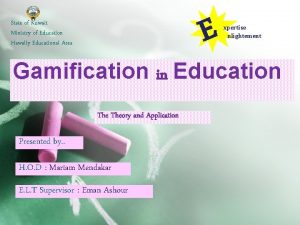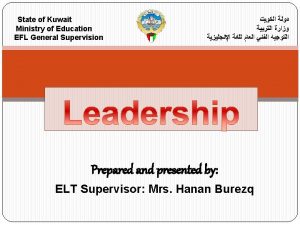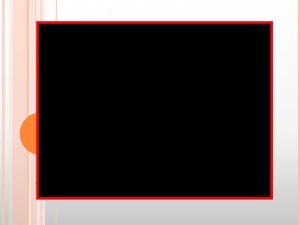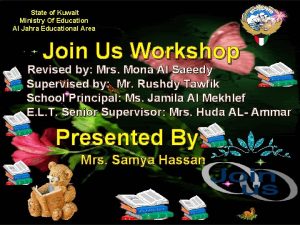State of Kuwait Ministry of Education KUWAIT NATIONAL






























































- Slides: 62

State of Kuwait Ministry of Education KUWAIT NATIONAL CURRICULUM Intermediate Education Kuwait National Curriculum and Standards Development Project Attaining Curriculum Standards

Objectives of this session • Find the difference between the modern competence-based assessment and evaluation approaches to the traditional. • Characterize the main forms of modern assessment and explain its role. • Use the different kinds of formative assessment methods in real classroom settings.

TASK (QUESTIONNAIRE )

WHAT IS ASSESSMENT? Process of data analysis that teachers use to get evidence about their learners’ performance and progress in English.

CLASSROOM ASSESSMENT & TEACHING *WHEN DO TEACHERS ASSESS STUDENTS? ANSWER: ALL THE TIME! *CLASSROOM ASSESSMENT IS THUS PART OF TEACHING. *IT IS NOT A SEPARATE ENTITY. IT IS THAT PART THAT INDICATES (TO THE TEACHER) WHETHER STUDENT PROGRESS IS TAKING PLACE. *TEACHING THEREFORE NEEDS TO ENSURE STUDENTS PROGRESS IS OVERT (IT IS MADE VISIBLE TO THE TEACHER). *[THIS CANNOT HAPPEN IF THE TEACHER IS TALKING AND THE STUDENTS ARE DOING

CATs CLASSROOM ASSESSMEN T TECHNIQUES

ASSESSMENT Attaining Curriculum Standards

PLEASE NOTE… • The curriculum standards are targets for all students. But it is important that students are guided to go beyond the curriculum standards. Thus the curriculum standards need to be considered as the achievement of the expected performance.

AT THE END OF THE LEARNING PROCESS. . Teachers need to know how effective their teaching is School institutions need evaluation for the learning process Students need to know how well they are doing Parents ask for their children report

ASSESSMENT. . . ? !? PREMISE ON ASSESSMENT THE MAIN PURPOSES OF ASSESSMENT: • TO GENERATE THE LEARNING PROGRESS AND • TO MEASURE THIS PROGRESS

The Need For and Purpose of Assessment The purpose of classroom assessment: Assessment fulfills this purpose by: improve how students learn improve what methods teachers use Allowing students and teachers to respond to information obtained from monitoring and evaluating student learning.

RESEARCH REVEALED THAT. . After Analyzing the impact of “paper and pencil” test. Reading and writing: Using grammar and vocab in single sentences. Matching and filling the gaps. Speaking: reciting rehearsed dialogues Listening: Simple test. These kinds of tests bring a strange message to children of the nature of language communication. It doesn’t also activate children’s natural capacities to work out with meaning from the input materials. Suggestion: use child’s friendly methods!

What is the child’s friendly method? “Child friendly methods” are assessment techniques that are related and familiar with the use of everyday activities in the classroom. If the traditional “pencil and paper” test must be used, teacher should combine it with: Self assessment Portfolio assessment Observation More reliable child friendly methods.

WHAT IS ASSESSMENT IN RELATION TO COMPETENCES? • This is a measure of how well students are learning and developing competences in line with the curriculum.

Effective Assessment Ø An effective standards-based assessment system promotes learning and provides accurate and meaningful information about student achievement. Ø The assessment system includes individual assessment. Ø Effective assessment is linked to standards and reflects important content that is actually taught. Ø The assessment accommodates diverse students

HOW CAN TEACHERS ASSESS? Teachers can assess students in many ways, but in this section the emphasis is on three key ways: • Assessing from marking written work (also includes drawing, painting, photographs, work carried out on the computer). • Assessing from students being involved in oral interactions (included presentations, debates, group interactions). • Assessing by observations (individually, as a group, or even the whole class).

Part 2 why and how to develop a new vision on assessment

BRIEF SYNTHESIS • Begin with what students can do, and consider their learning needs • Give students the support needed to progress • Relate the evaluation to standards of achievement • Use reports to describe students’ learning • Encourage students to take a more active

What is competencebased assessment?

TASK CBAS VS TAS Competence-based assessment system VS Traditional assessment system

Competency-based Assessment CONCEPT Assessment of actual performance in which competency statements describe outcomes expected from knowledge, skills and attitudes. Explicit standards of required FOUNDATION performance are defined by research. REQUIREMENTS Assessment is an integral part of the learning program. Assessment evidence is criterion- Traditional Assessment is based on learning ability to achievement. It is theoretically stating outcomes. Curriculum outcomes are defined by teaching staff/school/board or government. Assessment is independent of the learning program. Prior learning is recognized Assessment evidence is norm -

TYPES OF ASSESSMENT ASSESSM ENT FORMAL INFORMAL

INFORMAL ASSESMENT INFORMAL ASSESSMENT results from teachers' spontaneous day-to-day observations of how students behave and perform in class. • Spontaneous • Day-to-day • Observation • Perform in class

THE CHARACTERISTICS OF INFORMAL ASSESSMENT ØUnplanned ØNo strict rules for administration ØNo strict rules for interpretation ØReliance on teacher judgment ØSubject to modification during testing

EXAMPLES OF INFORMAL ASSESSMENT Discussions Peer Teaching Question Time 5 Minute Quiz

FORMAL ASSESSMENT is preplanned, systematic attempts to judge by the teacher to ascertain what students have learned. • Preplanned • Systematic • To judge what students have learnt

EXAMPLES OF FORMAL ASSESSMENTS Multiple-choice exam Short-answer or problemsolving exam Performance assessment

What does the research say?

Assessment OF Learning Assessment FOR Learning Assessment AS Learning

Planning with the End in Mind Assessment for Learning How will I know they are learning it? How will students demonstrate their knowledge and skills while they are learning? How will we monitor their progress? Process observation, conversations, …

Planning with the End in Mind Assessment of Learning (Evaluation) How will I know they have learned it? How will students demonstrate their knowledge and skills when they have finished learning? What evidence will be produced? Products

Planning with the End in Mind Assessment as Learning How will students learn through assessing his achievements? How will learner know if he grasped the taught material? Self-assessment Products

Task ASSESSMENTS OF LEARNING VS ASSESSMENT FOR LEARNING

Assessment for learning Assessment of learning Is done for the purpose of measuring what the learners can and cannot do during the learning process It is typically using examinations to test what students know and are able to do. It focuses on on-going assessment Process It focuses on Evaluation. products It can use more informal methods of assessment, which can include observation, performance, as well as quizzes and written assignments throughout the learning process. It is formative and can determine students’ prior strengths or learning gaps. The teacher takes a coaching role, giving students detailed feedback to tell them how they can do better. The purposes are to help teachers determine how student learning is developing, to identify what’s working and where problems are This process assesses the effectiveness of instruction and helps teachers determine how instruction has to change to help struggling Through formal testing, teachers report on what students HAVE LEARNED at the end of a unit or course. It is summative, and it is what teachers are most familiar with. The teacher’s role in evaluation is to assign grades to report to students and their parents how they did The purpose is to make decisions about next steps in learning Measures the learners’ abilities to meet outcomes after learning.

WHEN THE COOK TASTES THE SOUP, THAT'S ----- WHEN THE GUESTS TASTE IT, THAT'S ------! ROBERT STAKE 35

WHEN THE COOK TASTES THE SOUP, THAT'S FORMATIVE. WHEN THE GUESTS TASTE IT, THAT'S SUMMATIVE! ROBERT STAKE 36

FORMATIVE ASSESSMENT EXAMPLES AND TECHNIQUES

FORMATIVE ASSESSMENT INSTRUCTIONAL STRATEGIES • Observations • Effective questioning • Student record keeping

OBSERVATIONS • Go beyond walking around the room to see if students are on task or need clarification • Assist teachers in gathering evidence of student learning to inform instructional planning • Can be recorded and used as feedback for students about their learning or as data shared with them.

EFFECTIVE QUESTIONING • Is used to elicit immediate information about student learning • Allows an opportunity for deeper thinking and provides teachers with significant insight into the degree and depth of understanding [significant wait time] • Engage students in classroom dialogue that both uncovers and expands learning • Examples: • Checking for understanding (thumbs up/down, red/green cards) • Exit slips

STUDENT RECORD KEEPING • Helps students better understand their own learning as evidenced by their classroom work • Not only engages students in their learning but also helps them to see where they started and the progress they are making toward achieving the learning goal

PART THREE GENERAL BASIS FOR THE ASSESSMENT SYSTEM

ASSESSMENT IN CORRELATION WITH THE COURSE BOOK DESIGN Module 1 Modul e 2 Grade 6 course book Module 3 Module 4 3 Units 10 -11 -12 • 3 units • (1 -2 -3) • 3 units • (4 -5 -6) • 3 units • 7 -8 -9 One Module = A Learning unit


5 LEVELS OF ACHIEVEMENT FOR CLASSROOM ASSESSMENT Mark (Symbol) E V G S U Mark Description Grade Excellent 4 Very good 3 Good 2 Satisfactory 1 Unsatisfactory 0

RECORD OF ACHIEVEMENT FOR FINAL RESULTS (RAFR) INTERMEDIATE EDUCATION FINAL SCORE ( 100 GRADES ) 40% FORMATIVE ASSESSMENT 60% FOR SUMMATIVE ASSESSMENT

Distribution of Assessment Marks for the Intermediate Stage Assessment of Curriculum Standards Continual Classroom Assessment Semesters Formative Assessment Summative Assessment First Semester 40% 60% Second Semester 40% 60%

SYSTEM OF ASSESSMENT CONCERNING FORMATIVE ASSESSMENT IT INCLUDES: ORAL FLUENCY DISCUSSION WORK SHEET PRESENTATION QUIZZES PROJECT

HOW TO CALCULATE FORMATIVE ASSESSMENT • RECORDS OF FORMATIVE & SUMMATIVE ASSESSMENT (1) - COPY. XLSX

RECORD OF ACHIEVEMENT FORMATIVE ASSESSMENT (RAFA) General Competence 1 Curric. Stand. Date of assess. 1. 1 15. 09 19. 09 2. 10 16. 09 20. 09 G G V S V 2. 1 23. 09 8. 10 G V 2. 3 1. 2 1. 3 Level of achievement for each General Competence/ Numerical mark Level of achiev. General competences ﺍﻟﻜﻔﺎﻳﺎﺕ ﺍﻟﻌﺎﻣﺔ General Competence 2 Competence 3 Curric. Stand. Date of assess. Level of achiev. 3. 1 25. 09 3. 10 Curric. Stand. 3. 2 28. 09 4. 10 G G 4. 2 3. 3 6. 10 V 4. 3 V Date of assess. Level of achiev. 4. 1 G V 2. 2 5. 10 General Competence 4 25. 09 27. 09 30. 09 7. 10 G V S V G G 2 3 2 2 Final score per learni ng unit/ period 9 out of 12 75%

FORMATIVE ASSESSMENT GRADE = TOTAL AVERAGE POINTS OF A STUDENT X 40 NUMBER OF COMPETENCES IN THE SEMESTER X 4 REMARK: ASSESSMENT LEVEL SHOULDN’T EXCEED 4 GRADES

SUMMATIVE ASSESSMENT IT INCLUDES: WRITTEN ASSESSMENT ( EXAMS/ PROJECTS ) REMARK: THE MECHANISM OF REGISTERING THE RESULT OF SUMMATIVE ASSESSMENT *DEFINE THE NUMBER OF LEARNING UNITS *ASSESSING CURRICULUM STANDARDS OF THE LEARNING UNIT ONLY ONCE

THE EQUIVALENT OF ASSESSMENT GRADE AS FOLLOWING: POINTS STUDENT’S GRADE 4 9 - 10 3 8 - 8. 9 2 7 - 7. 9 1 5 -6. 9 0 0 -4. 9

RECORD OF ACHIEVEMENT FOR SUMMATIVE ASSESSMENT (RASA) General Competence 1 Curric. Stand. Date of assess. 1. 1 30. 09 1. 2 1. 3 Level of achiev. General competences General Competence 2 Competence 3 Curric. Stand. Date of assess. Level of achiev. G 2. 1 30. 09 G 3. 1 30. 09 S 2. 2 11. 10 V 3. 2 30. 09 11. 10 S 2. 3 11. 10 Level of achievement for each General Competence S 1 V 3 Curric. Stand. Date of assess. Level of achiev. General Competence 4 Curric. Stand. Date of assess. 4. 1 11. 10 G G 4. 2 30. 09 S G 4. 3 G 2 Level of achiev. G 2 Final score per learnin g unit/ period 8 out of 12 66, 6% ~ 67%

HOW TO CALCULATE SUMMATIVE ASSESSMENT GRADE FORMATIVE ASSESSMENT GRADE = TOTAL AVERAGE POINTS OF A STUDENT X 60 NUMBER OF COMPETENCES IN THE SEMESTER X 4

FINAL RANKING

TRY TO CALCULATE THE RESULT OF THESE ASSESSMENTS Ahmed Formativ e assessm Summati ent ve assessm ent 12 points 10 points

THE RESULT IS …………. 67. 5

HOW TO USE THE RESULTS OF ASSESSMENT? THE LEARNING ENHANCEMENT PROGRAM : LEP THREE COMPONENTS: REMEDIAL DEVELOPMENT ENRICHMENT

REPORTING STUDENTS’ RESULTS TO PARENTS PART A – SUBJECT-SPECIFIC ASSESSMENT ACHIEVEMENT IN THE SUBJECT BASED ON GENERAL COMPETENCES, AND REPORTED AGAINST 5 LEVELS OF ACHIEVEMENT: E, V, G, S, I. FOR ENGLISH LANGUAGE: General competence Listening and speaking Reading Writing Sem. 1 Sem. 2

REPORTING STUDENTS’ RESULTS TO PARENTS • COMMENTS: STRENGTHS AND SUGGESTED STEPS FOR IMPROVEMENT FOR BOTH SEMESTERS. COMMENTS (Sem. 1) [B. reads a wide variety of texts fluently and demonstrates particularly perceptive insights into the narrative texts we have studied - both books and short films. He contributes well to class discussions. He has made a pleasing effort this semester not to interrupt and speak over other students. His oral presentations are well prepared but he can get a bit carried away when in front of an audience and needs to keep the purpose in mind. In writing he brings in good ideas and effective vocabulary choices. To improve, B. needs to pay more attention to punctuation marks. ] COMMENTS (Sem. 1)

Thank you
 Ministry of education kuwait
Ministry of education kuwait Ministry of education morocco
Ministry of education morocco Ministry of national education romania
Ministry of national education romania State audit bureau of kuwait
State audit bureau of kuwait State audit bureau of kuwait
State audit bureau of kuwait National unification and the national state
National unification and the national state Ministry of national economy oman
Ministry of national economy oman Ministry of national development planning indonesia
Ministry of national development planning indonesia Ministry of education serbia
Ministry of education serbia Israeli ministry of education
Israeli ministry of education Ministry of education romania
Ministry of education romania Ministry of education armenia
Ministry of education armenia Ministry of higher education (afghanistan)
Ministry of higher education (afghanistan) تعليم الخاص مبارك الكبير
تعليم الخاص مبارك الكبير Kurdistan
Kurdistan Kurdistan
Kurdistan Kurdistan
Kurdistan Ministry of higher education saudi arabia
Ministry of higher education saudi arabia Ministry of education iceland
Ministry of education iceland Ministry of education and culture cyprus
Ministry of education and culture cyprus Ministry of education
Ministry of education Ministry of education
Ministry of education Ministry of education peru
Ministry of education peru Secondary engagement programme
Secondary engagement programme Hellenic ministry of education and religious affairs
Hellenic ministry of education and religious affairs Ministry of education
Ministry of education Ministry of education and research romania
Ministry of education and research romania Ministry of education
Ministry of education Ministry of education and science of the russian federation
Ministry of education and science of the russian federation Ministry of higher education erbil
Ministry of higher education erbil Ministry of higher education tunisia
Ministry of higher education tunisia Ministry of education moldova
Ministry of education moldova Ministry of education zone 1
Ministry of education zone 1 Ministry of higher education saudi arabia
Ministry of higher education saudi arabia General elt
General elt English supervision kuwait
English supervision kuwait Eor kuwait
Eor kuwait Nipt test kuwait
Nipt test kuwait Font finder from image
Font finder from image Which number on the map represents the country of kuwait?
Which number on the map represents the country of kuwait? Elt general supervision
Elt general supervision War in kuwait
War in kuwait Islands in kuwait
Islands in kuwait Kuwait university subsidiaries
Kuwait university subsidiaries Kuwait turkish bank istanbul
Kuwait turkish bank istanbul Kuwait fire department online
Kuwait fire department online Kuwait vision 2035
Kuwait vision 2035 Nizamuddin arshad
Nizamuddin arshad Investment opportunities kuwait
Investment opportunities kuwait Ikarus kuwait
Ikarus kuwait New kuwait
New kuwait Kuwait authority for partnership projects
Kuwait authority for partnership projects Diabetologist in kuwait
Diabetologist in kuwait Petroleum
Petroleum Islamic medical center kuwait
Islamic medical center kuwait Invasion of kuwait
Invasion of kuwait Kuwait vision 2035
Kuwait vision 2035 Southwest asia map kuwait
Southwest asia map kuwait Kuwait foreign petroleum exploration company k.s.c.
Kuwait foreign petroleum exploration company k.s.c. Kfh kuwait loan interest rate
Kfh kuwait loan interest rate Egov kuwait
Egov kuwait National forum of state nursing workforce centers
National forum of state nursing workforce centers Novosibirsk national research state university
Novosibirsk national research state university
